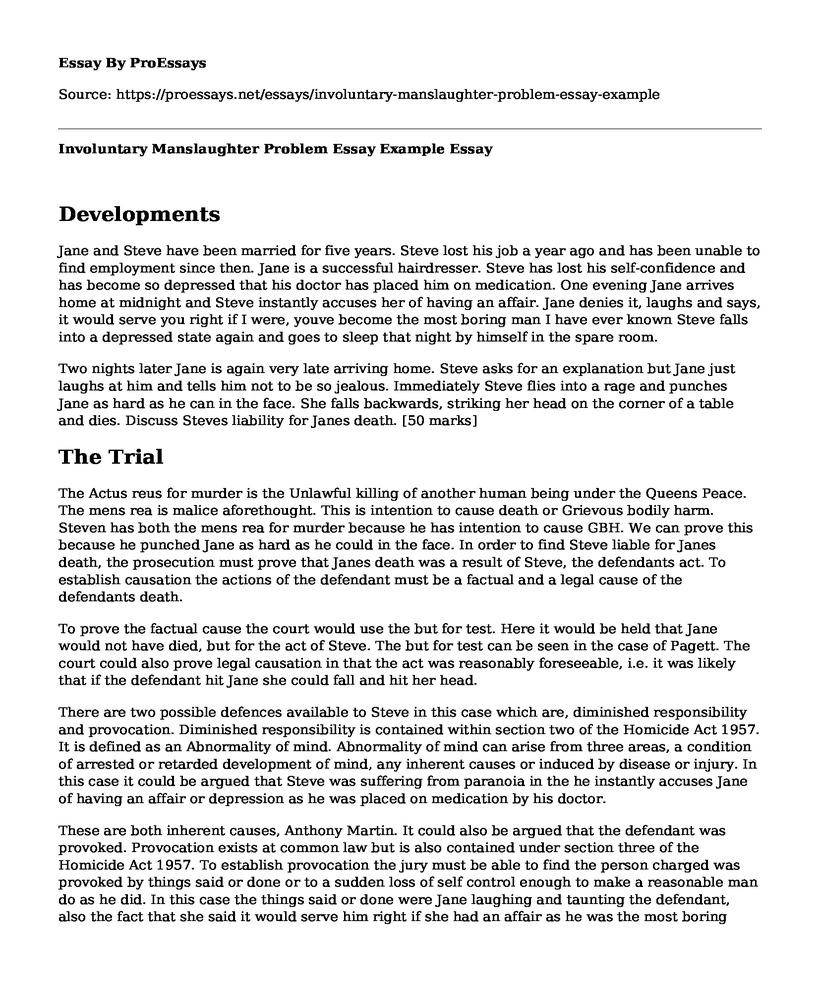Developments
Jane and Steve have been married for five years. Steve lost his job a year ago and has been unable to find employment since then. Jane is a successful hairdresser. Steve has lost his self-confidence and has become so depressed that his doctor has placed him on medication. One evening Jane arrives home at midnight and Steve instantly accuses her of having an affair. Jane denies it, laughs and says, it would serve you right if I were, youve become the most boring man I have ever known Steve falls into a depressed state again and goes to sleep that night by himself in the spare room.
Two nights later Jane is again very late arriving home. Steve asks for an explanation but Jane just laughs at him and tells him not to be so jealous. Immediately Steve flies into a rage and punches Jane as hard as he can in the face. She falls backwards, striking her head on the corner of a table and dies. Discuss Steves liability for Janes death. [50 marks]
The Trial
The Actus reus for murder is the Unlawful killing of another human being under the Queens Peace. The mens rea is malice aforethought. This is intention to cause death or Grievous bodily harm. Steven has both the mens rea for murder because he has intention to cause GBH. We can prove this because he punched Jane as hard as he could in the face. In order to find Steve liable for Janes death, the prosecution must prove that Janes death was a result of Steve, the defendants act. To establish causation the actions of the defendant must be a factual and a legal cause of the defendants death.
To prove the factual cause the court would use the but for test. Here it would be held that Jane would not have died, but for the act of Steve. The but for test can be seen in the case of Pagett. The court could also prove legal causation in that the act was reasonably foreseeable, i.e. it was likely that if the defendant hit Jane she could fall and hit her head.
There are two possible defences available to Steve in this case which are, diminished responsibility and provocation. Diminished responsibility is contained within section two of the Homicide Act 1957. It is defined as an Abnormality of mind. Abnormality of mind can arise from three areas, a condition of arrested or retarded development of mind, any inherent causes or induced by disease or injury. In this case it could be argued that Steve was suffering from paranoia in the he instantly accuses Jane of having an affair or depression as he was placed on medication by his doctor.
These are both inherent causes, Anthony Martin. It could also be argued that the defendant was provoked. Provocation exists at common law but is also contained under section three of the Homicide Act 1957. To establish provocation the jury must be able to find the person charged was provoked by things said or done or to a sudden loss of self control enough to make a reasonable man do as he did. In this case the things said or done were Jane laughing and taunting the defendant, also the fact that she said it would serve him right if she had an affair as he was the most boring man shed ever known.
This may be considered as cumulative provocation which the jury may consider Humphreys 1995. The test for loss of self control stems from Duffy, there was a sudden loss of self control as Steve immediately flew into a rage and it was sudden as there was no cooling off period as in the case of Ibrams and Gregory. The case of DPP v Camplin stated that the question is not whether a reasonable man in similar circumstances would be provoked to lose his self-control but also whether he would react to the provocation in the way the accused did. In this case the victim laughing and simply telling the defendant not to be jealous may not be sufficient enough provocation to justify the defendant punching her as hard as he could in the face.
Conclusion
A reasonable man of the same age and sex of the defendant, DPP v Bedder, would probably not have acted in this way. It is possible that Steve is Liable for the Murder of Jane as there is no break in the chain of causation, however the conviction may be reduced to involuntary manslaughter on the defence of diminished responsibility. It is questionable whether Steve could rely on the defence of provocation as it is unlikely he reacted to the provocation in the same way as that of a reasonable man.
Cite this page
Involuntary Manslaughter Problem Essay Example. (2021, Dec 02). Retrieved from https://proessays.net/essays/involuntary-manslaughter-problem-essay-example
If you are the original author of this essay and no longer wish to have it published on the ProEssays website, please click below to request its removal:
- Homeland Security Resilience Paper Example
- Marijuana Legalisation Essay Example
- Juvenile Corrections: Probation and Beyond - Essay Sample
- Crime: Learned Behaviour: Sutherland's Differential Association Theory - Essay Sample
- U.S. Government: Protect Citizens' Rights, End Domestic Violence - Essay Sample
- Free Report Example on Improving Living Standards Through Adequate Housing
- Paper Sample: Half of Prisoners Released Under Mandatory Supervision, Quarter Under Discretionary Parole







